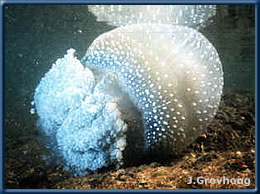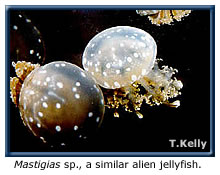

Phyllorhiza punctata

Cassiopea andromeda

Pennaria disticha

Carijoa riisei

Diadumene lineata
Phyllorhiza punctata
 White-spotted
jellyfish
White-spotted
jellyfish
Phylum Cnidaria
Class Scyphozoa
Order Rhizostomeae
Family Magistiidae
Description
The bell of this large jellyfish may reach 50 cm in diameter. It is typically
bluish-brown with many evenly distributed opaque white spots. It has eight
thick transparent branching oral arms which terminate with large brown bundles
of stinging cells. From each oral arm hangs a longer ribbon-like transparent
appendage.
A superficially similar, but smaller species of jellyfish, Mastigias
sp., is also thought to be an alien.
Habitat
In Hawaii these jellyfish are found swimming near the surface in the murky
waters near estuaries in harbors and embayments. Nothing is known about the
habitat of the tiny benthic stages of this species in Hawaii.
 Distribution
Distribution
Hawaiian Islands
Oahu - Pearl and Honolulu Harbors, Ala Wai Canal and Yacht Harbor, Kaneohe
Bay.
Native Range
Australia
Present Distribution
Australia, Hawaiian Islands, Caribbean, Gulf of Mexico.
Mechanism of Introduction
Unintentional, as ship-fouling scyphistomae or as ephyrae in ballast water.
Impact
Ecological impact unstudied in Hawaiian Islands, but these jellyfish are known
to eat planktonic crustaceans and fish eggs and larvae elsewhere. A population
explosion of P. punctata in the Gulf of Mexico,
where it is an alien species, appeared to threaten the local fish populations
and other commercially important species such as shrimp, menhaden, anchovies,
and crabs. No comparable population fluctuations are known to occur in Hawaiian
waters, but it has been reported that this jellyfish appears to be more common
in winter months.
Ecology
Feeding
Phyllorhiza has stinging cells or nematocysts in its tentacles, which are
used for protection and capturing plankton.
Reproduction
Basic cnidarian reproduction involves an asexually reproducing polyp stage,
alternating with a sexually reproducing medusoid stage. This reproductive
strategy is known as "alternation of generations". The scyphozoan
reproductive cycle is typically dominated by the medusoid stage. The adult
planktonic medusa is commonly referred to as a jellyfish. The planktonic planula
larvae of the sexually reproducing medusa typically settles to the bottom
where it attaches and grows (scyphistoma stage). It may then either directly
form additional scyphistoma via a process of budding, and/or develop into
a strobila, a benthic form which asexually produces and releases young medusa
known as ephyrae. This alternation of generations may facilitate the transport
of jellyfish by shipping through ballast water (planktonic planula, ephyrae
or medusa) or fouling (benthic scyphistoma or strobila).
Remarks
Under the name Cotylorhizoides pacificus, Cutress
(1961) indicated that this lndo-Pacific jellyfish was introduced from the
Philippine Islands, as ship-fouling scyphistomae, into Pearl Harbor between
1941-1945. It was restricted to Pearl Harbor until about 1950, but then in
1953-54 it appeared in Kaneohe Bay (Cutress 1961). Devaney and Eldredge (1977)
noted that this rhizostomid "certainly appears to be P.
punctata". Wrobel and Mills (1998), regard it as an Indo-Pacific
species also found in Hawaii and as introduced to the western tropical Atlantic
Ocean. Cooke (1984) felt that the taxonomy of the Hawaiian population was
unresolved, and that it should be referred to simply as a "mastigid".
We tentatively retain the name Phyllorhiza punctata
for convinience.
References
Cooke, W.J. 1984. New scyphozoan records for Hawaii: Anomalorhiza
shawi Light, 1921, and Thysanostoma loriferum
(Ehrenberg, 1835); with notes on several other rhizostomes. Proc. Biol. Soc.
Wash. 97:583-588.
Cutress, C.E. 1961. [Comment on introduced jellyfish in Hawaii] in: Doty,
M.S., 1961, Acanthophora, a possible invader
of the marine flora of hawaii. Pacific Science. 15(4): 547-552.
Devaney, D.M. and L.G. Eldredge. 1977. Class Scyphozoan. in Reef and Shore
Fauna of Hawaii. Section 1: Protozoa through Ctenophora. Bishop Museum Spec.
Pub. 64(1).
Wrobel, D. and C. Mills. 1998. Pacific Coast Pelagic Invertebrates. Sea Challengers,
Monterey. 108 p.
© 2002 Hawaii Biological Survey, Bishop Museum
contact